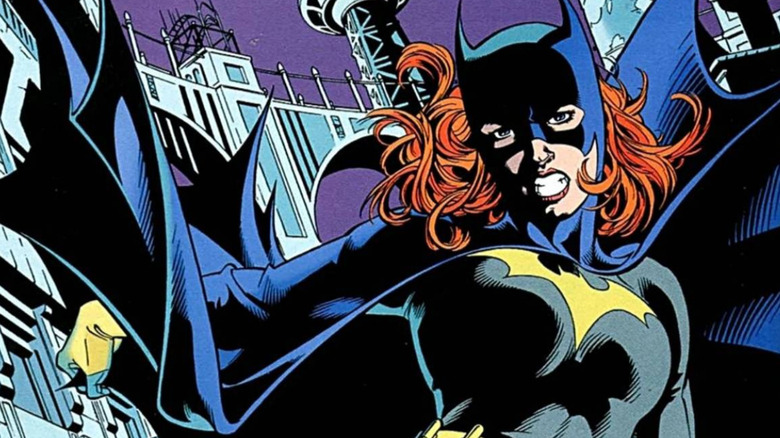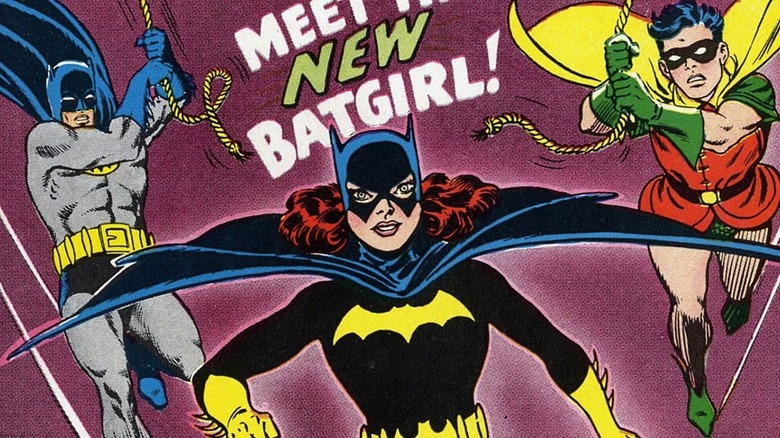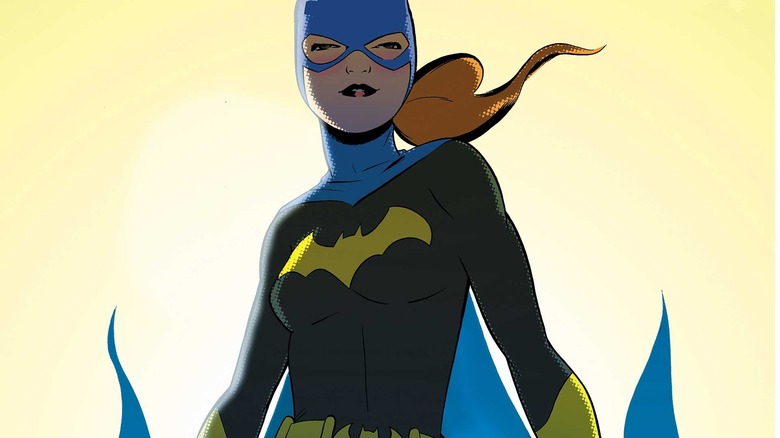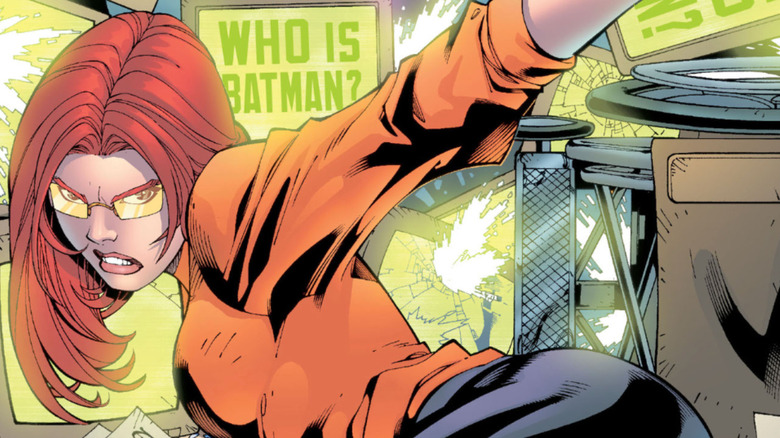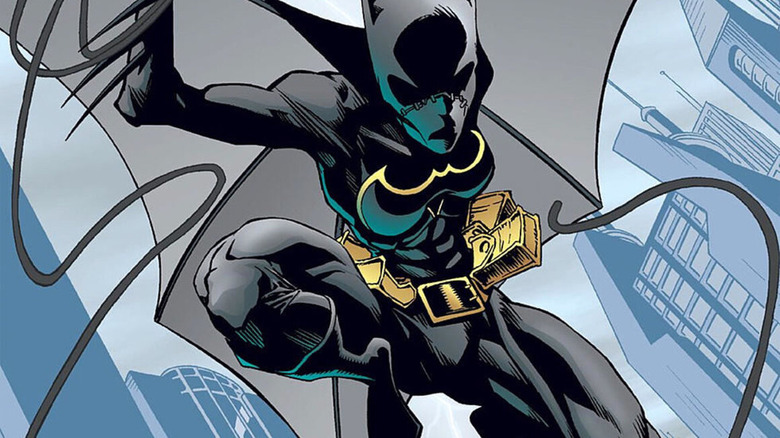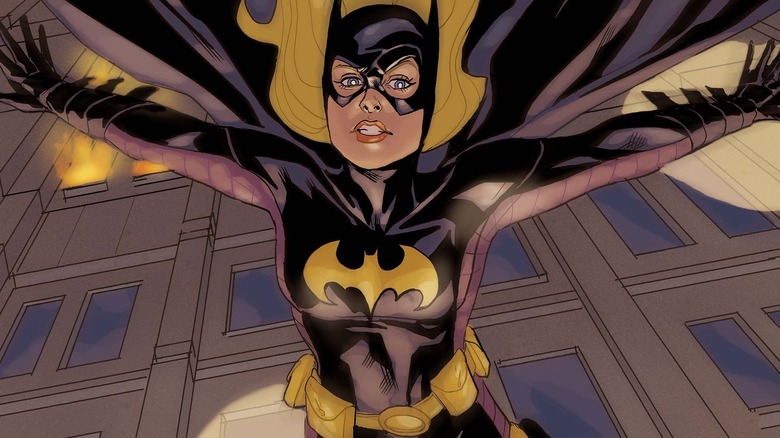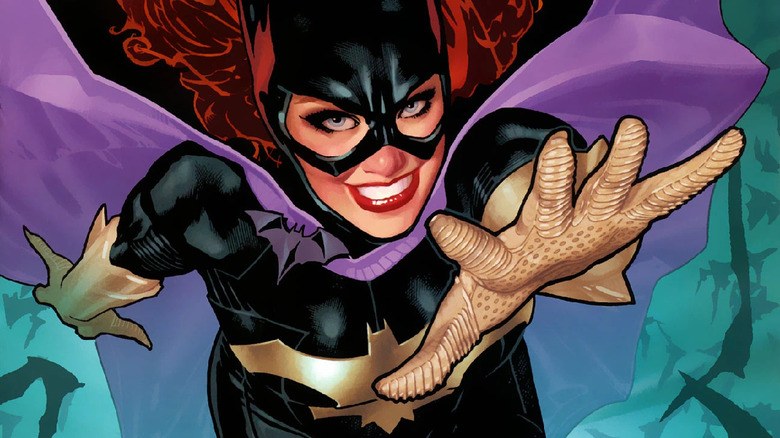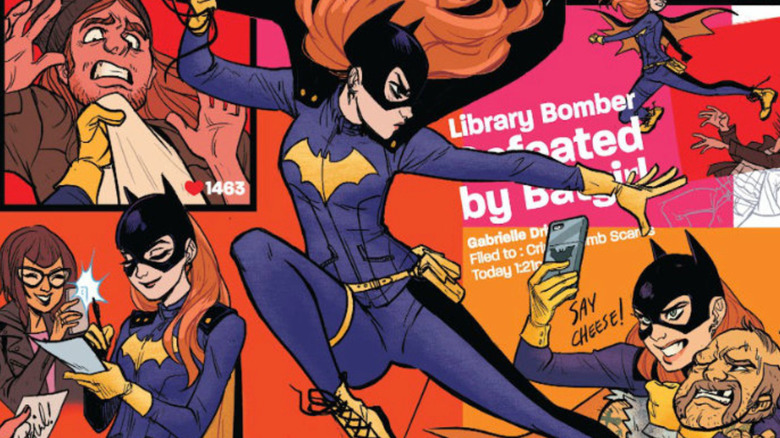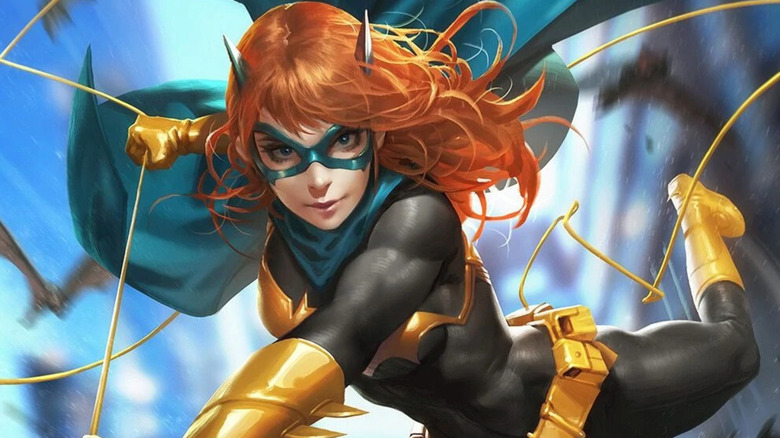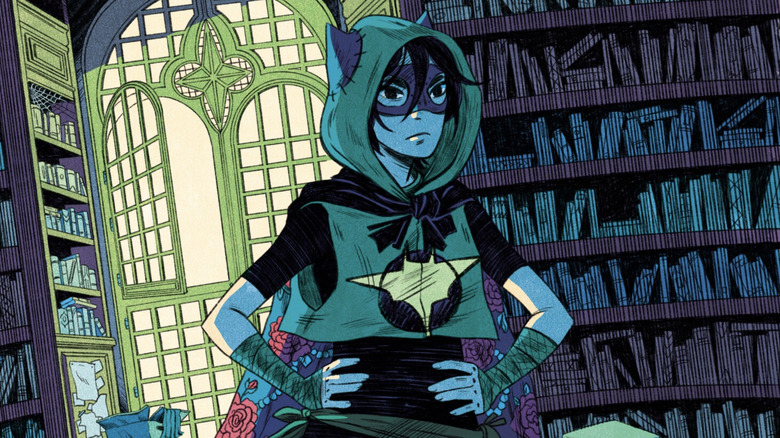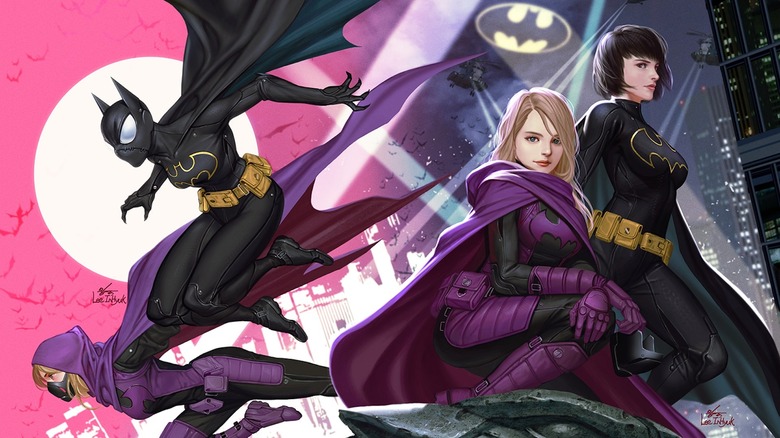The 10 Best Batgirl Comics To Read Now That The Movie Is Canceled
August 2, 2022, saw some unprecedented news: the near-complete "Batgirl" film has been canceled and will go unreleased. Apparently, Warner Bros. felt they could more easily recoup the movie's $90 million budget with a tax loophole than by following through with a release and pouring even more money into marketing.
"Batgirl," intended as the next installment of the DC Extended Universe, would've featured Leslie Grace as Barbara Gordon and chronicled her origin to become the titular heroine. She would've been the third actor to play the character in live-action, after Yvonne Craig in the 1960s "Batman" TV show and Alicia Silverstone in "Batman and Robin." Supporting characters would've included J.K. Simmons as her father Commissioner James Gordon, Brendan Fraser as the villainous Firefly, and Michael Keaton as Bruce Wayne/Batman.
If you're a fan of these characters, then not getting the chance to see the film is disappointing. Not to fret, though; if you're still craving a Batgirl fix, there are mountains of comics you can dive into. Here's a guide on where to start.
The Million Dollar Debut of Batgirl
Barbara Gordon wasn't the first Batgirl — that would be Betty Kane, who debuted in 1961. However, Betty didn't quite catch on; DC Comic editor Julius Schwartz wrote the character out in 1963.
Four years later, however, "Batman" TV producer William Dozier requested Schwartz create a new Batgirl for use in the TV series. Dozier was the one who suggested she be Commissioner Gordon's daughter. Barbara then debuted in Detective Comics #359 (written by Gardner Fox, art by Carmine Infantino), titled "The Million Dollar Debut of Batgirl," mere months before her first appearance on the small screen. This history is recounted in "Growing Up Gordon: The Early Years of Batgirl," published in issue #38 of "Back Issue!" Magazine.
Now as for the story itself, it's goofy. Barbara gets roped into crime-fighting because she dressed up as Batman for a costume ball. On the drive there, she spots Killer Moth attempting to kidnap Bruce Wayne and fights him off. Despite the Dynamic Duo's objections, Barbara becomes a full-time Batgirl. The issue is one of those comics that's historically important, and mainly useful for understanding how far these characters have come.
Read if: you're a compulsive completionist.
Where to read: print editions go into the $100s but you can read the issue on the digital comic service DC Universe Infinite.
Batgirl: Year One
Many DC comics since have emulated Frank Miller and David Mazzucchelli's 1987 issue "Batman: Year One," down to aping the subtitle. Naturally, one of those is "Batgirl: Year One." The 9-issue mini-series, released in 2003, was written by Scott Beatty and Chuck Dixon, with art supplied by Marcos Martin and Álvaro López. The story expands on Barbara's beginnings as Batgirl.
The issue doesn't discard her "Million Dollar Debut" origin story — the costume ball part is still intact. However, the story gives Barbara additional motivation. She wants to follow her father's footsteps into law enforcement, but overprotective as he is, he won't let her. So, she decides to become a vigilante so she can do it under the Commissioner's nose. Killer Moth also features, but is treated more comedically; the true villain is another, deadlier insect-themed villain, namely the pyromaniac Firefly.
The art is the book's strong suit. Martin pencils clean character designs and ample negative space in wide shots, meaning the action flows smoothly. López inks a vibrant color palette, with highlights of yellow and blue/purple complementing Batgirl's costume.
Since the "Batgirl" movie was set to be an origin story and feature Firefly, it's plausible it would've drawn inspiration from "Year One." I guess we'll never know, though.
Read if: You're a sucker for classical origin stories.
Where to read: Collection editions of "Batgirl: Year One," both its solo Deluxe Edition and its double packaging with "Robin: Year One," are out-of-print and expensive. However, the series can be read on DC Universe: Infinite.
Birds of Prey: Of Like Minds
I debated whether to include this since it's not technically a Batgirl comic, but the fact is that Barbara Gordon's time leading the Birds of Prey is just as important as her Batgirl tenure.
A little background: Barbara was infamously shot and paralyzed by the Joker in Alan Moore and Brian Bolland's 1988 graphic novel, "The Killing Joke." Kim Yale and John Ostrander reintroduced her during "Suicide Squad" as Oracle, an information broker who helps the superhero community. Oracle then partnered with Black Canary to form the Birds of Prey in 1999. That series' most acclaimed run was written by Gail Simone, who wrote issues #56-108.
Simone's kick-off arc, "Of Like Minds," brought the Huntress onto the Birds of Prey, rounding out the trio now synonymous with the team name. The villain of the arc is Savant (you might remember how, as played by Michael Rooker, he got his head blown off in "The Suicide Squad"), who captures Black Canary to force Oracle to give him Batman's identity. Despite the established character dynamics, the story is new reader friendly, with plenty of action and the sensual, wise-ass humor Simone is known for. It's proof that Barbara Gordon doesn't need to be Batgirl to kick ass.
Read if: you loved the "Birds of Prey" movie.
Where to read: The opening issues of Simone's "Birds of Prey" are included in two paperbacks, "Of Like Minds" (issues #56-61) and "Murder and Mystery (issues #56-67). These issues can also be read on, you guessed it, DC Universe Infinite.
Batgirl: Silent Knight
Barbara Gordon isn't the only Batgirl around. In 1999, Kelley Puckett and Damion Scott created a new heroine to step into the then-vacant role: Cassandra Cain. A young mute girl, Cassandra, or Cass, is the daughter of two of the world's greatest assassins: David Cain and Lady Shiva. David raised Cassandra from birth as a human weapon, his goal being to rewrite her brain so she could "read" movement as a language. As such, she knows less than a dozen words but is a martial artist who rivals Batman himself.
Cass quickly earned a solo "Batgirl" series in 2000, written by Puckett and Scott Peterson with art by Damion Scott. The first 12 issues are known as, in a fitting pun, "Silent Knight." The issues have a loose story following Cass' accumulation to the Bat-family; Bruce and Barbara are both regular characters and mentor her.
The comic's art reflects Cass' characterization. Since she's silent and interprets the world through movement, the comic is action-driven, not dialogue-dependent. This results in whip-neck pacing that's a blast to read. One of my favorite pieces of art in the book is the opening of issue #5; a single-page spread of a gun pointed at Cass' head. The boxed-in, close-up framing is a marvelous use of perspective.
Read if: You like your comics breathless and action-packed.
Where to read: "Batgirl" issues #1-12 are collected as "Batgirl Volume 1: Silent Knight," and can also be read on DC Universe Infinite.
Batgirl: Stephanie Brown
Next up is Batgirl no. 3, Stephanie Brown. The daughter of Riddler knock-off Cluemaster, she was introduced as Spoiler in Detective Comics #647 (Chuck Dixon and Tom Lyle). After a brief tenure as Robin, she became Batgirl after Cassandra vacated the role. Her adventures were chronicled by Bryan Q. Miller and a rotating team of artists in a solo "Batgirl" series published from 2009 to 2011.
Miller is primarily a television writer; he got involved in DC Comics because he met Geoff Johns while writing for "Smallville." With his TV roots, it's not surprising he wrote Stephanie like Buffy Summers; she's a plucky quipster who has to balance college life with superheroics. While she often gets knocked down, she always pulls herself back up. Like she did with Cass, Barbara appears as Stephanie's mentor.
Highlights of the series include Batgirl teaming up with Supergirl in issue #13 to fight Bela Lugosi's Dracula, who's been brought to life in a science experiment mishap. Then, Stephanie opens issue #15 with an abbreviated (but accurate) recounting of the Bat-family's history. Finally, Stephanie introduces the surly Damian Wayne to the joys of a moon bounce at the end of issue #17.
This was the final "Batgirl" comic before DC relaunched their universe with the New 52 initiative. This scuffled Miller's plans; issue #24 peeks at stories that might've been if his "season 2" of "Batgirl" transpired. Still, as Stephanie argues with the book's final words, "it's only the end if you want it to be."
Read if: You're a "Buffy" fan.
Where to read: Miller's "Batgirl" run has been collected twice, first as a three-volume edition ("Batgirl Rising," "The Flood," and "The Lesson") and a two-volume "Batgirl: Stephanie Brown" edition. The run can be read in total on DC Universe Infinite.
Batgirl: The Darkest Reflection
When the New 52 launched in 2011, Gail Simone had the chance to write Barbara again — this time as Batgirl. The relaunched continuity put Barbara back into her old role, eventually explained as the result of experimental surgery restoring her ability to walk. Simone wrote the series on and off for 34 issues; the first six issues make up a story arc titled "The Darkest Reflection."
"The Darkest Reflection" is, maybe ironically, some of Simone's darkest work. Her humor isn't totally gone, but the core of the story is Barbara's PTSD; her body has healed but her mind hasn't. The first issue even ends with Batgirl failing to save someone because she was frozen by a flashback to the Joker's attack on her.
The villain of "The Darkest Reflection" is, fittingly, called the Mirror. His name is Jonathan Mills; he survived a car wreck but his family didn't. Convinced his near-death experience shouldn't have just been "near," Mills' goal is to kill other people who've miraculously survived disasters, Barbara being one of them. The Mirror embodies Barbara's lingering fears and struggles to move on. Her goal isn't just to defeat the villain but to accept her second chance and make the most of it; these arcs are intertwined.
Read if: You like your Bat-comics broody.
Where to read: Simone's "Batgirl" run was collected across 5 volumes; the first six issues make up volume 1, "The Darkest Reflection." The issues can be read on DC Universe Infinite.
The Batgirl Of Burnside
After Simone left the title in 2014, Barbara's life went in a different direction. Deciding she needs a break from the grime of Gotham, Barbara moves to the neighborhood of Burnside with her new roommate Frankie.
These 17 issues, #35 to #52, are much lighter than Simone's and have a slice-of-life feel. Barbara's personal life gets as much spotlight as her antics as Batgirl. Issue #45 is all about the wedding of Barbara's friend Alysia, with no supervillains to foil in sight. Brendan Fletcher and Cameron Stewart's writing evokes Miller's previous handling of "Batgirl," but with a more 2010s flavor. The art by Babs Tarr is reminiscent of Bryan O'Malley's pencils on "Scott Pilgrim."
One of the most divisive things about the run is the prevalence of social media in it. Barbara, still a computer geek even if she's not Oracle, decides to use social media to boost Batgirl's popularity. She's practically the first superhero influencer; if the run had come five years later, we definitely would've seen Batgirl starring in TikToks.
Side note: the Batgirl costume which debuted in this run is the one that the film costume would've been based on.
Read if: You think superhero comics could use more slice-of-life storytelling.
Where to read: The run is collected both across three volumes ("The Batgirl of Burnside," "Family Business," and "Mindfields") and as a whole in a hardcover "Batgirl of Burnside" omnibus. The series is also available on DC Universe Infinite.
Batgirl: Art of the Crime
The New 52 wound up reigning for only five years. In 2016, DC did a second relaunch of their comics universe: DC Rebirth. Like most DC titles, "Batgirl" was relaunched and ran for 50 issues until 2020. The best segment of the run, written by Mairghread Scott with art by Paul Pelletier, is sandwiched in the middle of the run: issues #26-36 (plus Annual #1). The series is broken up into three arcs: "Art of the Crime," "Old Enemies," and "Terrible."
Tonally, Scott's "Batgirl" is closer to Simone's run than Fletcher/Stewart's. Pelletier's pencils are more photo-realistic while Norm Rapmund's inking is more muted; the art feels as grounded as the writing does. Cementing the shift, Barbara swaps out her purple Burnside costume for a more classical blue-and-yellow one. The run emphasizes Barbara's detective skills, chronicling her investigations of an art thief, assassination attempts on a reformist politician, and serial killings that could be the work of her brother James Gordon Jr.
If there's a theme of this short and sweet run, it's getting back up. Barbara's PTSD from her paralyzation is again explored, but Scott avoids retreading old territory by offering a new angle: Barbara is bitter that she ever considered herself lesser while she was disabled. Issue #27 also features Barbara discovering a male acquaintance's body stuffed in a fridge, which can't be anything but an inversion of the original "Women in Refrigerators" story.
Read if: You like character-driven detective stories.
Where to read: Scott's run is collected in "Batgirl" volumes 5, "Art of the Crime," and 6, "Old Enemies." If like me, you can't stand having just isolated volumes 5 and 6 on your bookshelf, the issues can also be read on DC Universe Infinite.
Shadow of the Batgirl
Sarah Kuhn and Nicole Giuex's "Shadow of the Batgirl" is a YA graphic novel, in the same vein as "The Oracle Code" or "Under the Moonlight: A Catwoman Tale," designed as an easy introduction to comics for young, female readers. The book is a reimagining of Cassandra Cain's origin, exploring how she became Batgirl and her early tutelage with Barbara. However, the comic applies a lighter touch than Puckett and Scott's original Cass comics. There's less focus on her lethality and more on her insecurities. What remains is her design to escape her past and be a hero like Batgirl.
Kuhn admits in her introduction that, "I always saw myself as the sidekick" and that this is what drew her to Cass. Kuhn then channeled these emotions into the book. "I realized Cass also has trouble seeing herself as the hero. She just can't picture it. She thinks all she can be is a villain, a sidekick. She thinks she's disposable. I wanted to reach through the pages and tell her you're not. You are everything."
Gieux's art is round and whimsy, reflecting the lighter tone but also having the experimentation with panel layout and momentum you'd expect from a Cassandra Cain comic.
Read if: You've never read a DC comic in your life.
Where to read: Released as a graphic novel, "Shadow of the Batgirl" is available in print only as a collected edition. Shockingly, it is not available on DC Universe Infinite.
Batgirls
The most recent comic on this list, "Batgirls" is an ongoing title written by Michael Conrad and Becky Cloonan with art by Jorge Corona. As you might've guessed from the title, the series puts the three holders of the Batgirl title together. Cassandra and Stephanie are now sharing the name, while Barbara hangs around as their mentor. All three of the women share an apartment, turning their crime-fighting into a true team operation.
The first arc, "One Way or Another," features the Batgirls square off against a new version of the villain Spellbinder, who's spreading subliminal messages in Gotham. However, the highlight of the series is the character dynamics. It's a classic comedy set-up; Stephanie's bubbly and optimistic, Cassandra's quiet and morose, and Barbara's the straight woman caught in the middle. Throw them all together and their interactions make the book.
All three of the Batgirls have their fans, and this series definitely reads like an attempt at placating them all simultaneously. So far, it's working.
Read if: you think roommate sitcoms need more superhero action.
Where to read: "Batgirls" Volume 1 is set to be released on November 1, 2022. The first two issues can be read on DC Universe Infinite; more will come on a monthly basis. As a freshly published, ongoing series, your local comic shop might have some of the issues in stock too; the series is currently on issue #8 with #9 set to arrive on August 9.
